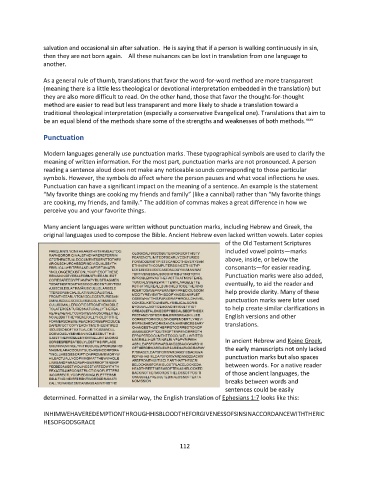Page 114 - Doctrine and History of the Preservation of the Bible revised
P. 114
salvation and occasional sin after salvation. He is saying that if a person is walking continuously in sin,
then they are not born again. All these nuisances can be lost in translation from one language to
another.
As a general rule of thumb, translations that favor the word-for-word method are more transparent
(meaning there is a little less theological or devotional interpretation embedded in the translation) but
they are also more difficult to read. On the other hand, those that favor the thought-for-thought
method are easier to read but less transparent and more likely to shade a translation toward a
traditional theological interpretation (especially a conservative Evangelical one). Translations that aim to
be an equal blend of the methods share some of the strengths and weaknesses of both methods. xxxv
Punctuation
Modern languages generally use punctuation marks. These typographical symbols are used to clarify the
meaning of written information. For the most part, punctuation marks are not pronounced. A person
reading a sentence aloud does not make any noticeable sounds corresponding to those particular
symbols. However, the symbols do affect where the person pauses and what vocal inflections he uses.
Punctuation can have a significant impact on the meaning of a sentence. An example is the statement
“My favorite things are cooking my friends and family” (like a cannibal) rather than “My favorite things
are cooking, my friends, and family.” The addition of commas makes a great difference in how we
perceive you and your favorite things.
Many ancient languages were written without punctuation marks, including Hebrew and Greek, the
original languages used to compose the Bible. Ancient Hebrew even lacked written vowels. Later copies
of the Old Testament Scriptures
included vowel points—marks
above, inside, or below the
consonants—for easier reading.
Punctuation marks were also added,
eventually, to aid the reader and
help provide clarity. Many of these
punctuation marks were later used
to help create similar clarifications in
English versions and other
translations.
In ancient Hebrew and Koine Greek,
the early manuscripts not only lacked
punctuation marks but also spaces
between words. For a native reader
of those ancient languages, the
breaks between words and
sentences could be easily
determined. Formatted in a similar way, the English translation of Ephesians 1:7 looks like this:
INHIMWEHAVEREDEMPTIONTHROUGHHISBLOODTHEFORGIVENESSOFSINSINACCORDANCEWITHTHERIC
HESOFGODSGRACE
112

